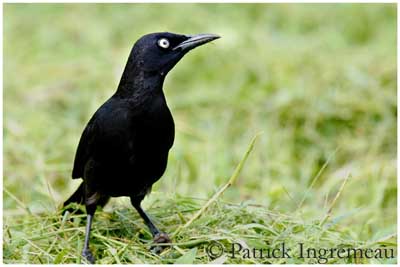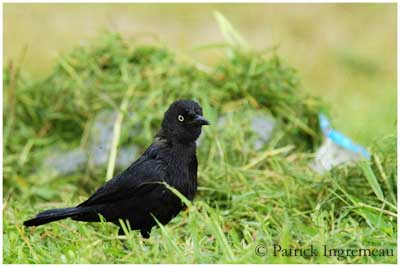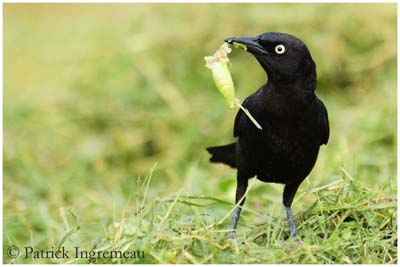
Carib Grackle
Quiscalus lugubris
Passeriforme Order – Icteridae Family
BIOMETRICS :
Length : 23-27 cm
LONGEVITY: Up to 15 years
DESCRIPTION:
Carib Grackle is a common and abundant New World tropical blackbird.
Adult male shows entirely black plumage, with slight purplish gloss. Tail is relatively long, but less than in other grackles’ species. Its tail is graduated and wedge-shaped.
The strong bill is black, with slightly down curved culmen at the tip. Eyes are bright yellowish-white. Legs and feet are black.
Adult female has duller plumage, showing dark sooty brown colour on upper parts. Tail is blackish-brown and shows a dull green gloss.
Underparts are paler with whitish throat, grey-buff breast, and darker greyish-brown flanks and vent.
On the head, crown and neck are grey-brown. We can see a whitish supercilium, contrasting with grey-brown lores and ear-coverts.
DIET:
Carib Grackle feeds largely on garbage and discarded food. It feeds on the ground by scraping, searching for insects and other invertebrates.
PROTECTION / THREATS / STATUS:
Carib Grackle is common and abundant in its range, and this species is not threatened.
Fr: Quiscale merle
All : Trauergrackel
Esp : Zanate Caribeño
Ital : Gracchio dei Caraibi
Nd : Caribische Troepiaal
Photographs by Patrick Ingremeau
TAMANDUA
Text by Nicole Bouglouan
Sources:
A GUIDE TO THE BIRDS OF COLOMBIA by Steven L. Hilty and William L. Brown - Princeton University Press – ISBN 069108372X
NEW WORLD BLACKBIRDS – THE ICTERIDS by Alvaro Jaramillo and Peter Burke – Helm - ISBN : 0713643331
Wikipedia (Wikipedia, The Free Encyclopedia)

Juvenile resembles female, but its eyes are dark, becoming paler little by little. Young female is brown, whereas young male is darker. After fledging, young male shows black patches of feathers appearing on brown plumage.
We can find 8 subspecies, separated in two groups, one with brownish female, and the other with rather blackish females.
VOICE: SOUNDS BY XENO-CANTO
Carib Grackle utters some “chuck” and whistles as alarm calls. Whistle is often used for aerial danger, or when the bird is very excited. The “chuck” note is more reserved for ground predators.
The most common call is a loud “queek-queek-queek-queek”.
Carib Grackle calls may vary according to the locality and the subspecies, giving dialects.
HABITAT:
Carib Grackle lives in open areas, cultivated areas with trees, sometimes along the edges of gallery forests. This species can live close to human habitation and in towns.
RANGE:
Carib Grackle is resident in the Lesser Antilles, and in the North of South America, east of the Andes, from Colombia, north and centre of Venezuela, the Guianas and north-eastern Brazil, and also in Trinidad. This species has been introduced in Tobago in 1905.

BEHAVIOUR:
Carib Grackle is gregarious. It feeds on garbage and discarded food, and frequents the open-air restaurants. It also forages on beaches, in sand and among rocks. It feeds on the ground, often in small groups.
These birds frequent communal roosts in trees at night, where they congregate in large noisy flocks, up to 200 to 300 birds.
Carib Grackles can become very aggressive against human, and they attack if some people approaches. Several birds often form a group in order to attack a predator such as dog or mongoose. When they are foraging together, it is usual to see some displays such as the bird walking with dropped wings and the head held upright, as a signal.
During breeding season, male performs “mate guarding” because female may sometimes mate with rivals. This species is as monogamous or polygynous, according to the range.
Male performs displays at nest-site. It ruffles its plumage while singing, with vibrating spread wings, and cocked, fanned tail. These displays occur at the tree where the colony nests.

FLIGHT:
Carib Grackle performs bouncing flight with strong wing beats and glides with closed wings. In flight, tail is held as a V.
REPRODUCTION:
Carib Grackle often nests in colonies with several nests in the same tree, usually palms or tall trees, sometimes in low bushes over water. Breeding season varies according to the geographic range.
Nest is built by female. It is a bulky nest, an open cup made with twigs, dead leaves and dry grass, and often reinforced and lined with mud. It is usually situated in forks or on a branch, but against the tree trunk.
Female lays 2 to 4 greenish-white eggs, sometimes pale blue, with dark markings. Incubation lasts about 12 days, by female alone.
Young fledge about 14 days after hatching.
Male helps female for feeding the young.
Carib Grackle is a host of the Shiny Cowbird, but grackles rejects cowbird eggs out of the nest. About 60% of females perform this rejection.
This species can produce one or two broods per year, according to the range.
